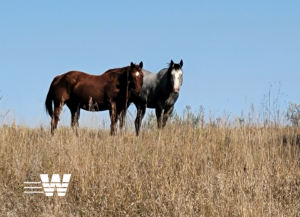
“Ward Labs has been instrumental in our decision-making process regarding how, when and which group of hay bales to feed to our cattle for optimum performance.”
– Matt C. Cherry County, NE
Want more expert insights?
Resources for Forage Producers
Webinars
Editorials
Blogs
 Recommended Testing
Recommended Testing
Near-infrared Spectroscopy
Near-infrared Spectroscopy is a widely trusted method for analyzing forages, providing livestock producers with crucial information such as the protein and energy level in forages. This analysis also provides forage quality indexes, relative feed value, and forage quality for determining fair pricing when buying and selling hay.
We recommend NIRS analysis as a marketing tool for forage producers showcasing high-quality hay and for livestock producers aiming to optimize supplementation strategies for improved herd performance.
Want more expert insights?
Resources for Cattlemen
Webinars
Editorials
Blogs
Recommended Testing

Near-infrared Spectroscopy
Near-infrared Spectroscopy is a widely trusted method for analyzing forages, providing livestock producers with crucial information such as the protein and energy level in forages. This analysis also provides forage quality indexes, relative feed value, and forage quality for determining fair pricing when buying and selling hay.
We recommend NIRS analysis as a marketing tool for forage producers showcasing high-quality hay and for livestock producers aiming to optimize supplementation strategies for improved herd performance.
Adding nitrates to your forage analysis
High-nitrate forages can pose serious health risks to ruminant animals like cattle, sheep, and goats. Nitrate toxicity may lead to severe consequences, including abortions without warning signs and, in some cases, sudden death in otherwise healthy animals.
Testing for nitrates is critical, especially in nitrate-accumulating forages like sorghum varieties, oats, millets, and corn stalks.
Adding minerals to your forage analysis
Mineral issues result in lost income through poor animal health and production. Testing forages for mineral concentrations and then determining a mineral supplementation program built around those forages can ensure animal health, and productivity and optimize financial outcomes.
F-10 Cattle Ration Analysis
Analyzing mixed rations ensures they meet the protein and energy specifications they were formulated for, helping to maintain optimal nutritional balance. Collecting 3-4 samples to evaluate ration variability can also reveal potential issues in the mixing process.
A consistent, homogenous ration is essential for supporting rumen health, which in turn allows animals to achieve their genetic potential and deliver peak production performance.
Prussic Acid in the Field Kit
Ruminants such as cattle, sheep, and goats, are more susceptible to prussic acid poisoning due to chewing their cud. As those animals ruminate, the plant cell membranes are damaged. This allows the enzyme access to dhurrin, thereby releasing HCN into the rumen. The HCN is then absorbed directly into the bloodstream where is binds hemoglobin. The bound hemoglobin cannot transfer oxygen to individual cells and death by asphyxiation is the result. While it is rarely an issue, prussic acid should be routinely tested before grazing sorghum, sudan, and Johnson grass. The consequences of not being diligent can be deadly!
W-4 Livestock Water Suitability
Good water is essential for your livestock’s health and performance. Our testing analyzes key factors like total dissolved solids (TDS), electrical conductivity (EC), hardness, sodium, pH, nitrates, and sulfates. Monitoring these parameters helps ensure your animals have safe, high-quality water for optimal growth, productivity, and health.
Want more expert insights?
Resources for Horses
 Recommended Testing
Recommended Testing
Near-infrared Spectroscopy
Near-infrared Spectroscopy is a widely trusted method for analyzing forages, providing crucial information such as the protein and energy level in forages. This analysis also provides forage quality indexes, relative feed value and forage quality for determining fair pricing when buying and selling hay.
We recommend NIRS analysis for horses to determine how much protein and energy supplementation is needed to meet their macronutrient requirements. Furthermore, we provide the parameters needed to calculate non-structural carbohydrates (NSC) to determine if a forage is suitable for horses with metabolic issues such as laminitis.
Adding minerals to your forage analysis
Mineral issues result in lost income through poor animal health and production. Testing forages for mineral concentrations and then determining a mineral supplementation program built around those forages can ensure animal health, productivity, and optimize financial outcomes.
Adding Selenium to your forage analysis
Selenium is an essential trace mineral. Horses are especially sensitive to high levels of selenium in the forage. If you live in an area with known high levels of selenium in the soil. Analyzing pastures and hay for selenium concentrations would be advised prior to adding any micronutrient supplements to avoid health risks associated with selenium toxicity including hair loss, sloughing of hooves, muscle damage, and even death.
Want more expert insights?
Resources for Small Ruminant Producers
Webinars
Blogs
 Recommended Testing
Recommended Testing
Near-infrared Spectroscopy
Near-infrared Spectroscopy is a widely trusted method for analyzing forages, providing livestock producers with crucial information such as the protein and energy level in forages. This analysis also provides forage quality indexes, relative feed value and forage quality for determining fair pricing when buying and selling hay.
We recommend NIRS analysis as a marketing tool for forage producers showcasing high-quality hay and for livestock producers aiming to optimize supplementation strategies for improved herd performance.
Adding nitrates to your forage analysis
High-nitrate forages can pose serious health risks to ruminant animals like cattle, sheep, and goats. Nitrate toxicity may lead to severe consequences, including abortions without warning signs and, in some cases, sudden death in otherwise healthy animals.
Testing for nitrates is critical, especially in nitrate-accumulating forages like sorghum varieties, oats, millets, and corn stalks.
Adding minerals to your forage analysis
Mineral issues result in lost income through poor animal health and production. Testing forages for mineral concentrations and then determining a mineral supplementation program built around those forages can ensure animal health, productivity, and optimize financial outcomes.
F-10 Ration Analysis
Analyzing mixed rations ensures they meet the protein and energy specifications they were designed for, helping to maintain optimal nutritional balance. Collecting 3-4 samples to evaluate ration variability can also reveal potential issues in the mixing process.
A consistent, homogenous ration is essential for supporting rumen health, which in turn allows animals to achieve their genetic potential and deliver peak production performance.
W-4 Livestock Water Suitability
Good water is essential for your livestock’s health and performance. We have consulted with numerous packgoat producers struggling with ‘water-belly’ issues due to hard water. Our testing analyzes key factors like total dissolved solids (TDS), electrical conductivity (EC), hardness, sodium, pH, nitrates, and sulfates. Monitoring these parameters helps ensure your animals have safe, high-quality water for optimal growth, productivity, and health.
Prussic Acid in the Field Kit
Ruminants such as cattle, sheep and goats, are more susceptible to prussic acid poisoning due to the chewing of their cud. As those animals ruminate, the cell membranes are damaged. This allows the enzyme access to dhurrin, thereby releasing HCN into the rumen. The HCN is then absorbed directly into the bloodstream where is binds hemoglobin. The bound hemoglobin cannot transfer oxygen to individual cells and death by asphyxiation is the result. While it is something that rarely is an issue, prussic acid should be routinely tested prior to grazing sorghum, sudan, and Johnson grass, the consequences of not being diligent can be deadly!
Understanding Prussic Acid: Risks & Testing Grazed Forages for Animal Safety
Want more expert insights?
Resources for Poultry Producers
 Recommended Testing
Recommended Testing
F-11 Proximate Analysis
This test measures the macronutrients needed to understand if your flock is meeting its protein and energy requirements.
Adding minerals to your feed analysis
Mineral issues result in lost income through poor animal health and production. Testing for mineral concentrations and evaluating dietary levels compared to bird requirements can empower producers to make the right dietary supplement decisions to ensure animal health and productivity.
Mycotoxin Screenings
Livestock health issues and poor performance due to the presence of mycotoxins in feed can result in significant economic losses. Screening ingredients and formulated diets can allow producers to make the right decisions to avoid devastating health issues and losses.
W-4 Livestock Water Suitability
Good water is essential for your livestock’s health and performance. Our testing analyzes key factors like total dissolved solids (TDS), electrical conductivity (EC), hardness, sodium, pH, nitrates, and sulfates. Monitoring these parameters helps ensure your animals have safe, high-quality water for optimal growth, productivity, and health.
Want more expert insights?
Resources for Pork Producers
 Recommended Testing
Recommended Testing
F-12 Swine Ingredients
This test measures the macronutrients needed to understand if your pigs are meeting their protein and energy requirements. Includes crude protein, amylase-treated neutral detergent fiber, crude fat and ash.
F-13 Swine Diets
This test measures the macronutrients needed to understand if your pigs are meeting their protein and energy requirements. With more in depth analysis in addition to the F-12 parameters, this test package also includes acid detergent fiber, and starch.
Adding minerals to your feed analysis
Mineral issues result in lost income through poor animal health and production. Testing for mineral concentrations and evaluating dietary levels compared to pig requirements can empower producers to make the right dietary supplement decisions to ensure animal health and productivity.
Mycotoxin Screenings
Livestock health issues and poor performance due to the presence of mycotoxins in feed and result is significant economic losses. Screening ingredients and formulated diets can allow producers to make the right decisions to avoid devastating health issues and losses.
W-4 Livestock Water Suitability
Good water is essential for your livestock’s health and performance. Our testing analyzes key factors like total dissolved solids (TDS), electrical conductivity (EC), hardness, sodium, pH, nitrates, and sulfates. Monitoring these parameters helps ensure your animals have safe, high-quality water for optimal growth, productivity, and health.
Want more expert insights?
Resources for Pet Food and Treats
 Recommended Testing
Recommended Testing
F-14 Pet Food Guaranteed Analysis
This test measures macronutrients crude protein, crude fiber, and crude fat. This is the bare minimum currently required by AAFCO for pet treat labels.
F-11 Proximate Analysis
This test measures macronutrients crude protein, crude fiber, and crude fat and ash. Ash is needed to calculate the metabolizable energy in pet treats or food.
Adding minerals to your feed analysis
The addition of minerals on a pet food or treat label can help pet owners confidently choose your product knowing it provides not only macronutrients but also the trace minerals required by their furry friends.

